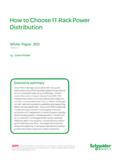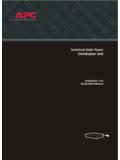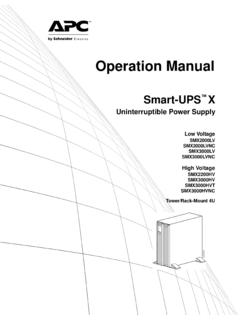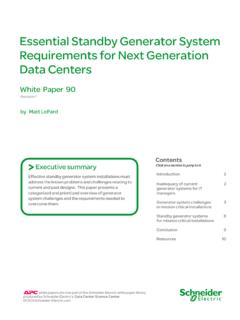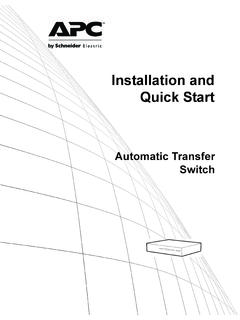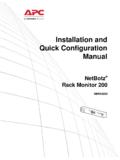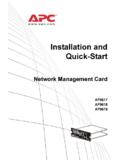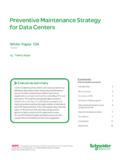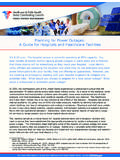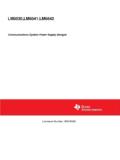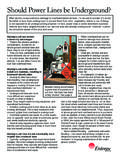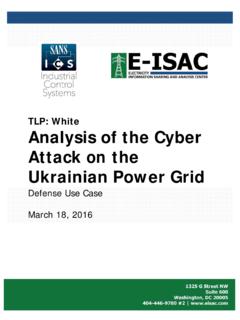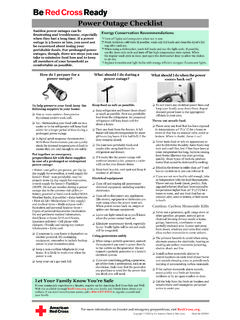Transcription of Data Center Temperature Rise During Cooling …
1 data Center Temperature Rise During a Cooling System Outage White Paper 179. Revision 1. By Paul Lin Simon Zhang Jim VanGilder > Executive summary The data Center architecture and its IT load significantly affect the amount of time available for continued IT. operation following a loss of Cooling . Some data Center trends such as increasing power density, warmer supply temperatures , the right-sizing of Cooling equipment, and the use of air containment may actually increase the rate at which data Center temperatures rise. However, by placing critical Cooling equipment on backup power , choosing equipment with shorter restart times, maintaining adequate reserve Cooling capacity, and employing thermal storage, power outages can be managed in a predictable manner. This paper discusses the primary factors that affect transi- ent Temperature rise and provides practical strategies to manage Cooling During power outages.
2 By Schneider Electric White Papers are now part of the Schneider Electric white paper library produced by Schneider Electric's data Center Science Center data Center Temperature Rise During a Cooling System Outage Introduction IT equipment is typically backed up by uninterruptible power supplies (UPSs) which supply power until generators come on-line following the loss of utility power to the facility. Howev- er, Cooling system components such as CRAC (Computer Room Air Conditioner) or CRAH. (Computer Room Air Handler) fans, chilled water pumps, and chillers (and associated Cooling towers or dry coolers) are typically not connected to UPSs and are generally connected to backup generators. Consequently, the data Center supply air Temperature may rise quickly following a power failure. While much attention is devoted to data Center Cooling system design, most of that effort is aimed at improving the efficiency and reliability of its normal operation under utility power .
3 The lack of attention paid to emergency operating conditions is due partly to a lack of simple tools for data Center designers and operators to predict Cooling performance under such conditions. However, a recently developed modeling tool 1, makes it easy to estimate data Center temperatures following the loss of Cooling for various facility architectures, back-up power connectivity choices, and, when applicable, chilled-water (thermal) storage volumes. Meanwhile, planning for a power -outage is becoming more critical as data Center profession- als follow industry trends like right-sizing Cooling capacity, increasing rack power density, adopting air containment, and increasing supply air temperatures . The latter trend is driven in part by ASHRAE's recently-revised Thermal Guidelines 2 which allows warmer data Center air temperatures than previously recommended.
4 Without other compensating design choices, all of these trends reduce the window of time for safe and reliable operation following a power outage. Essentially all of the electrical power consumed in a data Center is transformed into heat. Factors affect- Under normal, steady, operating conditions this heating rate is balanced by the rate of ing the rate of Cooling . During a Cooling failure, the heating rate is balanced instead by the rate at which data Center heat is absorbed by the data Center air, IT equipment, and the building envelope 3. For facilities cooled by chilled-water CRAHs, water in the piping system and any storage tanks heating also absorbs heat assuming the chilled water can be circulated using backup power . For a fixed IT load, the larger the volume of the data Center , the slower the rate at which temperatures will rise During a Cooling outage.
5 However, as more IT equipment is added to a given facility, the air volume and building envelope plays a diminishing role in moderating the rate of heating and the thermal mass 4 of the IT equipment itself becomes more important. Although perhaps unintuitive, even the hot insides of an operating server contributes thermal mass which slows the rate of data - Center heating. (As the server inlet air heats up, the effectiveness at which the server can transfer heat to the internal airstream is reduced;. this forces the balance of the server heat dissipation to be absorbed by its own solid compo- nents such as the chassis and motherboard.). 1. Zhang, X. and VanGilder, J., 2011, Real-Time data Center Transient Analysis , Proceedings of InterPACK, Portland, Oregon, July 6-8. 2. ASHRAE. 2011, Thermal Guidelines for data Processing Environments, Developed by ASHRAE.
6 Technical Committee 3. data Center building envelops are typically well insulated and play only a small role in moderating the rate of heating. 4. Thermal mass is the capacity of an object to store thermal energy. In a sense, the servers, walls, etc. act as thermal sponges During a Cooling outage and return the heat after Cooling is restored. Schneider Electric data Center Science Center White Paper 179 Rev 1 2. data Center Temperature Rise During a Cooling System Outage Chilled-water systems featuring traditional CRAHs or row-based coolers can offer advantages over fluid and air-cooled DX systems when facing a loss of primary power . 5 First, with no compressor or other refrigeration-cycle components, CRAHs consume less power than DX. units and are therefore easier to power by UPS and/or generator. Secondly, any chilled- water storage, if available, can be utilized immediately by CRAHs with only minimal backup power needed.
7 By contrast, glycol-cooled and water-cooled DX systems require more backup power and cannot take advantage of the thermal storage until the DX CRAC (Direct Expansion Computer Room Air Conditioner) units can be restarted which may take several minutes. Air-cooled CRAC DX units offer the least emergency-performance potential as the entire system, including dry coolers (which transfer the heat to the outside air) must be supplied with backup power and, again, may require a lengthy re-start period. To illustrate the heating of a data Center following the loss of utility power , we consider examples based on two different predictive models: Well-mixed-air model Detailed computational fluid dynamics (CFD) model The well-mixed-air model idealizes the data Center as a single CRAH or CRAC and a single IT load with perfectly well-mixed air. So, at any given time, there is only one uniform data Center air Temperature , one plenum Temperature , one cooler supply Temperature , etc.
8 The model is only strictly correct in the aggregate not precise for any particular location but serves as an adequate representation of IT inlet temperatures for the purposes in this paper. The simple well-mixed model includes design parameters such as chilled-water thermal storage as well as UPS and generator power connectivity for CRAH fans, chilled water pumps, and the chiller plant. The speed and simplicity of this model makes it easy to study > Assumptions for and visualize the results of a variety of scenarios quickly. Because we are presently most Example 1 concerned with understanding the important physics related to and developing design strategies for power -outage scenarios in general (rather than designing any one specific Well-mixed data Center air facility), the well-mixed model is the primary tool we use here. data Center dimensions: 30m (100ft) length x 24m (80ft) width x Detailed CFD simulations, on the other hand, require a skilled analyst, and generally take 4m (12ft) height with 600 mm (24.)
9 In) plenum many hours of computational time to produce a useful result. Furthermore, time-varying or Raised- floor Cooling , chilled-water transient data Center predictions are particularly complex and are, therefore, not routinely CRAHs, no air containment performed. However, in return for the considerable complexity, CFD can provide detailed Chilled water supply Temperature spatial variations in Temperature over the course of time following a power outage. set-point: C (45 F). Chilled water T: C (15 F). CRAH airflow: 45 m3/s (96,000. cfm). Well-mixed-air model example CRAH supply set-point: 20 C Figure 1 shows the response of a typical legacy data Center (see sidebar) to the loss of (68 F) primary power using the well-mixed model. Immediately following the power failure, the room No supplemental thermal storage air Temperature rises quickly while the plenum Temperature remains fairly constant as the IT load: 400 kW.
10 CRAH units remain off . The generator starts after 1 minute and provides power to the Average rack power density: kW CRAH fans and chilled water pumps. The room Temperature drops then rises again as Average rack mass: 545 kg (1200 does the supply and plenum temperatures - since the chilled water in the piping system lb) warms. At 11 minutes, the chiller starts Cooling the chilled water and all temperatures trend UPS backup for IT equipment only back down to their normal-operation values. For this example, the room air Temperature only All IT and Cooling equipment marginally exceeds the allowable threshold for about 3 minutes and then remains unaccepta- connected to generator bly high until about 17 minutes after the power outage. Generator start time: 60 s Chiller restart time: 10 min No heat transfer through or thermal mass of walls 5. For information on the different types of Cooling systems, see White Paper 59, The Different Technolo- gies for Cooling data Centers Schneider Electric data Center Science Center White Paper 179 Rev 1 3.
